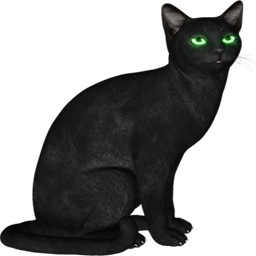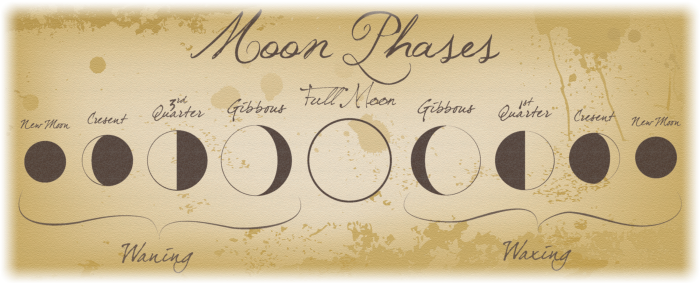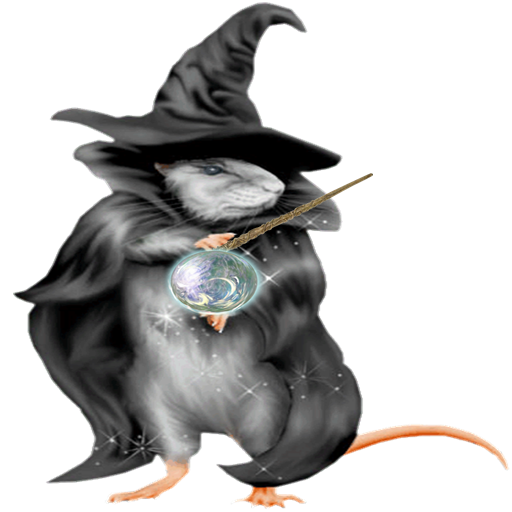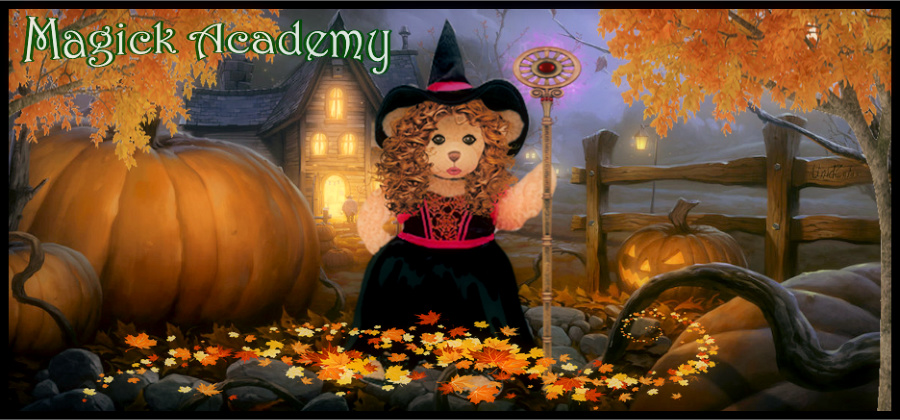
Black Cats Myths

In the United States and other North American nations, it is considered bad luck if a black cat should cross your path. Black cats were associated with witches. These bigoted tales are rooted in the fear originating during early settlement of North America. Folklore includes stories of witches assuming the shape of black cats or of the feline companions acting as witches' familiars.
The rationale for the association likely stemmed from the cat's nocturnal nature and was heightened by a black cat's natural and obvious ability to be nearly invisible at night. Added to this uncertainty is the ignorance brought about by unfamiliar surroundings and suspicion of anything unusual.
In England, giving a black cat to a bride is thought to bring her good luck.
To fishermen, black cats ensure a safe journey home.
Black cats are considered good luck. That is, unless you happen to be in Yorkshire, England, where the locals share the American superstition about black cats crossing one's path.
Celtic folklore contains stories of the Cat Sith, a mythological creature that took the form of a large black cat with a white spot on its chest. view could go bad or good such is the nature of the Fay.[Not sure what you mean in last sentence].
In the 16th century, Italians believed that a black cat laying on the bed of an ill person would bring on certain death.
Scottish superstition holds that good luck will come to the homeowner who finds a black cat visiting his or her front porch. Lore maintains that a black cat's appearance at your home leads to great wealth.
In ancient Egypt, black cats were so revered that killing one was deemed a capital offense. In ancient Egypt, people paid homage to Bastet, the cat goddess who represented prosperity and truth. Bastet often was depicted as a woman with the head of a cat, frequently with dark or black coloration. To gain favor from the goddess, Egyptian households kept black cats as pets.
The Bombay cat - the blackest of the black cats - was developed in Louisville, Kentucky, in the late 50s. A true black cat is not all black at all; they have small white spot in the center of the chest. Many myth and legend talk about that one little white spot.
This concludes the notes for this lesson. Please note that we will be continuing this topic in our next lesson.
Professor Thaddeus Daysong, Myths & Legends teacher

Moon Phases for the rest of 2015

Here are the dates for the moon phases for the rest of 2015.
- Last Quarter October 4, Su. 02:08 PM October 4, Su. 09:08 PM
- New Moon October 12, Mo. 05:06 PM October 13, Tu. 12:06 AM
- First Quarter October 20, Tu. 01:32 PM October 20, Tu. 08:32 PM
- Full Moon October 27, Tu. 05:05 AM October 27, Tu. 12:05 PM
- Last Quarter November 3, Tu. 04:25 AM November 3, Tu. 12:25 PM
- New Moon November 11, We. 09:47 AM November 11, We. 05:47 PM
- First Quarter November 18, We. 10:28 PM November 19, Th. 06:28 AM
- Full Moon November 25, We. 02:44 PM November 25, We. 10:44 PM
- Last Quarter December 2, We. 11:42 PM December 3, Th. 07:42 AM
- New Moon December 11, Fr. 02:29 AM December 11, Fr. 10:29 AM
- First Quarter December 18, Fr. 07:15 AM December 18, Fr. 03:15 PM
- Full Moon December 25, Fr. 03:11 AM December 25, Fr. 11:11 AM
 |
Eye on the Sky |
 |
The sky is an extremely active place. Here are some of the astronomic events that are occuring over the next few months.
October 1 - Comet C/2013 US10 Catalina. Newly discovered comet C/2013 US10 Catalina may reach naked eye visibility on October 1. The comet will continue to brighten and could reach magnitude 5 by November 6.
October 8 - Draconids Meteor Shower. The Draconids is a minor meteor shower producing only about 10 meteors per hour. It is produced by dust grains left behind by comet 21P Giacobini-Zinner, which was first discovered in 1900. The Draconids is an unusual shower in that the best viewing is in the early evening instead of early morning like most other showers. The shower runs annually from October 6-10 and peaks this year on the the night of the 8th. The second quarter moon will block out all but the brightest meteors this year. If you are patient, you may be able to spot a few good ones. Best viewing will be in the early evening from a dark location far away from city lights. Meteors will radiate from the constellation Draco, but can appear anywhere in the sky.
October 11 - Uranus at Opposition. The blue-green planet will be at its closest approach to Earth and its face will be fully illuminated by the Sun. It will be brighter than any other time of the year and will be visible all night long. This is the best time to view Uranus. Due to its distance, it will only appear as a tiny blue-green dot in all but the most powerful telescopes.
October 16 - Mercury at Greatest Western Elongation. The planet Mercury reaches greatest western elongation of 18.1 degrees from the Sun. This is the best time to view Mercury since it will be at its highest point above the horizon in the morning sky. Look for the planet low in the eastern sky just before sunrise.
October 13 - New Moon. The Moon will located on the same side of the Earth as the Sun and will not be visible in the night sky. This phase occurs at 00:06 UTC. This is the best time of the month to observe faint objects such as galaxies and star clusters because there is no moonlight to interfere.
October 21, 22 - Orionids Meteor Shower. The Orionids is an average shower producing up to 20 meteors per hour at its peak. It is produced by dust grains left behind by comet Halley, which has been known and observed since ancient times. The shower runs annually from October 2 to November 7. It peaks this year on the night of October 21 and the morning of October 22. The first quarter moon will set shortly after midnight leaving fairly dark skies for what should be a good show. Best viewing will be from a dark location after midnight. Meteors will radiate from the constellation Orion, but can appear anywhere in the sky.
October 26 - Venus at Greatest Western Elongation. The planet Venus reaches greatest eastern elongation of 46.4 degrees from the Sun. This is the best time to view Venus since it will be at its highest point above the horizon in the morning sky. Look for the bright planet in the eastern sky before sunrise.
October 26 - Conjunction of Venus and Jupiter. A conjunction of Venus and Jupiter will take place on October 26. The two bright planets will be visible within 1 degree of each other in the early morning sky. Look to the east just before sunrise for this impressive planetary pair.
October 27 - Full Moon, Supermoon. The Moon will be located on the opposite side of the Earth as the Sun and its face will be will be fully illuminated. This phase occurs at 12:05 UTC. This full moon was known by early Native American tribes as the Full Hunters Moon because at this time of year the leaves are falling and the game is fat and ready to hunt. This moon has also been known as the Travel Moon and the Blood Moon. This is also the last of three supermoons for 2015. The Moon will be at its closest approach to the Earth and may look slightly larger and brighter than usual.
October 28 - Conjunction of Venus, Mars, and Jupiter. A rare, 3-planet conjunction will be visible on the morning of October 28. The planets Venus, Mars, and Jupiter will all form a tight 1-degree triangle in the early morning sky. Look to the east just before sunrise for this spectacular event.
November 5, 6 - Taurids Meteor Shower. The Taurids is a long-running minor meteor shower producing only about 5-10 meteors per hour. It is unusual in that it consists of two separate streams. The first is produced by dust grains left behind by Asteroid 2004 TG10. The second stream is produced by debris left behind by Comet 2P Encke. The shower runs annually from September 7 to December 10. It peaks this year on the the night of November 5. The second quarter moon will block out all but the brightest meteors this year. If you are patient, you may still be able to catch a few good ones. Best viewing will be just after midnight from a dark location far away from city lights. Meteors will radiate from the constellation Taurus, but can appear anywhere in the sky.
November 11 - New Moon. The Moon will located on the same side of the Earth as the Sun and will not be visible in the night sky. This phase occurs at 17:47 UTC. This is the best time of the month to observe faint objects such as galaxies and star clusters because there is no moonlight to interfere.
November 17, 18 - Leonids Meteor Shower. The Leonids is an average shower, producing an up to 15 meteors per hour at its peak. This shower is unique in that it has a cyclonic peak about every 33 years where hundreds of meteors per hour can be seen. That last of these occurred in 2001. The Leonids is produced by dust grains left behind by comet Tempel-Tuttle, which was discovered in 1865. The shower runs annually from November 6-30. It peaks this year on the night of the 17th and morning of the 18th. The first quarter moon will set shortly after midnight leaving fairly dark skies for what could be a good show. Best viewing will be from a dark location after midnight. Meteors will radiate from the constellation Leo, but can appear anywhere in the sky.
November 25 - Full Moon. The Moon will be located on the opposite side of the Earth as the Sun and its face will be will be fully illuminated. This phase occurs at 22:44 UTC. This full moon was known by early Native American tribes as the Full Beaver Moon because this was the time of year to set the beaver traps before the swamps and rivers froze. It has also been known as the Frosty Moon and the Hunter's Moon.
December 7 - Conjunction of the Moon and Venus. A conjunction of the Moon and Venus will take place on the morning of December 7. The crescent moon will come with 2 degrees of bright planet Venus in the early morning sky. Look to the east just before sunrise.
December 11 - New Moon. The Moon will located on the same side of the Earth as the Sun and will not be visible in the night sky. This phase occurs at 10:29 UTC. This is the best time of the month to observe faint objects such as galaxies and star clusters because there is no moonlight to interfere.
December 13, 14 - Geminids Meteor Shower. The Geminids is the king of the meteor showers. It is considered by many to be the best shower in the heavens, producing up to 120 multicolored meteors per hour at its peak. It is produced by debris left behind by an asteroid known as 3200 Phaethon, which was discovered in 1982. The shower runs annually from December 7-17. It peaks this year on the night of the 13th and morning of the 14th. The crescent moon will set early in the evening leaving dark skies for what should be an excellent show. Best viewing will be from a dark location after midnight. Meteors will radiate from the constellation Gemini, but can appear anywhere in the sky.
December 22 - December Solstice. The December solstice occurs at 04:48 UTC. The South Pole of the earth will be tilted toward the Sun, which will have reached its southernmost position in the sky and will be directly over the Tropic of Capricorn at 23.44 degrees south latitude. This is the first day of winter (winter solstice) in the Northern Hemisphere and the first day of summer (summer solstice) in the Southern Hemisphere.
December 21, 22 - Ursids Meteor Shower. The Ursids is a minor meteor shower producing about 5-10 meteors per hour. It is produced by dust grains left behind by comet Tuttle, which was first discovered in 1790. The shower runs annually from December 17-25. It peaks this year on the the night of the 21st and morning of the 22nd. This year the waxing gibbous moon will be bright enough to hide most of the fainter meteors. If you are patient, you might still be able to catch some of the brighter ones. Best viewing will be just after midnight from a dark location far away from city lights. Meteors will radiate from the constellation Ursa Minor, but can appear anywhere in the sky.
December 25 - Full Moon. The Moon will be located on the opposite side of the Earth as the Sun and its face will be will be fully illuminated. This phase occurs at 11:11 UTC. This full moon was known by early Native American tribes as the Full Cold Moon because this is the time of year when the cold winter air settles in and the nights become long and dark. This moon has also been known as the Moon Before Yule and the Full Long Nights Moon.
December 29 - Mercury at Greatest Eastern Elongation. The planet Mercury reaches greatest eastern elongation of 19.7 degrees from the Sun. This is the best time to view Mercury since it will be at its highest point above the horizon in the evening sky. Look for the planet low in the western sky just after sunset.
Be sure to read up on each event. Remember the skies change daily!

Professor Bentley Blackstorm, Head, Astronomy Department
